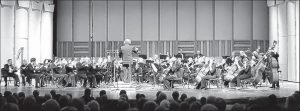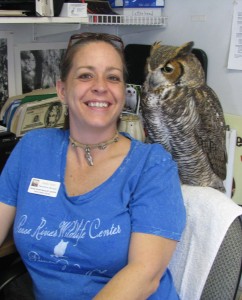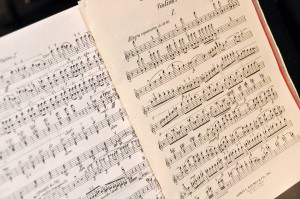
Vittorioso
March 29, 2015
Combined Presenters’ Introductions, Movie Names & Program Notes
1. (no introduction)
OPENING: William Tell Overture, Rossini
Movie: THE LONE RANGER
Notes:
Rossini was the most popular opera composer in history until his retirement. He was nicknamed “The Italian Mozart” for his song-like melodies and his music was often compared to ‘champagne’. William Tell premiered in 1829 and was the last of Rossini’s 39 operas, although he lived another 40 years and continued to compose other forms of music. Today the opera is remembered mostly for its Overture which is in four parts, each following without pause: Dawn, Storm, Call to the Cows (the calm after the storm), and the Finale – March of the Swiss Soldiers, the very familiar high energy gallop replete with horns and trumpets.
2.
Deep in the world of CIA covert operations in Soviet Russia, this was the movie version of Tom Clancy’s first novel, with some big hitters leading the cast: Sean Connery, Alec Baldwin and James Earl Jones. A huge financial success, it also won the Oscar for Best Sound Editing and others from the British Academy Film Awards.
The film: The Hunt for Red October
The music: Finlandia, Sibelius
Notes:
Finnish composer Jean Sibelius composed Finlandia for the Press Celebrations of 1899, a covert protest against increasing censorship from the Russian Empire. It was the last of seven pieces performed as accompaniment to a tableau depicting episodes from Finnish history. The work is mostly turbulent and rousing, evoking the political struggle of the time, but at the end, quiets into a hymn of reverence and national pride. Finlandia was performed, at that time in history, under different titles in order to avoid censorship. But for nationalists, its message remained clear.
3.
A fun romp with a fantastic soundtrack of popular music, this movie starred a pair of giant comedic TV actors who got to make music with James Brown, Aretha Franklin, Ray Charles, Cab Calloway and John Lee Hooker while they got the band back together, trying to do a good deed and stay out of jail. OK, not exactly Academy Award material, but it has been named as one of the 50 Greatest Comedy Films of all Time.
The film: The Blues Brothers
The music: Sabre Dance, Khachaturian
Notes:
Sabre Dance is a movement in the final act of Khachaturian’s ballet Gayane, when the dancers display their skills with sabres! The composer’s best-known and recognizable work, it became an American jukebox hit in 1948. Since then it has been the accompaniment for circuses, magicians, in TV shows, animated films, commercials, and even video games. Its wild frenzy is the perfect ‘chase scene’ soundtrack!
4.
Nominated for 12 Academy Awards, winner of 7, including Best Picture, Director, and Original Score. The film is deemed “culturally significant” by the Library of Congress and was described as the director’s “gift to his mother, to his people, and in a sense to himself.” The score was written by one of the great film composers of our time.
The film: Schindler’s List
The music: Theme from Schindler’s List, John Williams
Notes:
One of America’s most prolific composers of film soundtracks, Williams is known for Star Wars, ET, Jaws, Indiana Jones and the list of instantly recognizable scores goes on and on! A little known fact: he also composed the theme song for the TV show Gilligan’s Island. Tonight’s offering has a very different atmosphere and has won the composer many awards. The violin solo is haunting, sad, hopeful and unforgettable.
5.
In 1957, the Academy awarded 7 Oscars for this highly praised film, including Best Picture. The fictional story takes place in World War II, at a prison camp in Thailand. British prisoners, regardless of their rank, are commanded into forced labor to build a bridge. The music used for this theme is forever inextricably linked to the story.
The film: Bridge over the River Kwai
The music: Colonel Bogey March, Kenneth Alford
Notes:
The “Colonel Bogey March” was written in 1914 by Lieutenant F. J. Ricketts, a British Army bandmaster, who composed under the pseudonym Kenneth Alford, since professional lives outside the military were frowned upon at that time. Supposedly, the tune was inspired by a military man and golfer – Colonel Bogey – who whistled a characteristic two-note phrase instead of shouting “Fore!” His name was adopted for the standard scoring system in golf – ‘Bogey’ is now a golfing term meaning “one over par”. Composer Malcolm Arnold wrote a counter march for his film score and the two have been entwined ever since.
6.
This 1971 Italian-French drama, based on a novella written by German author Thomas Mann, tells a tale of forbidden love amidst a cholera epidemic. Mahler’s Adagietto opens and closes the film, beautifully framing the drama and romance of the movie that won the Cannes Film Festival in 1971 and was nominated for an Academy Award in 1972.
The film: Death in Venice
The music: Symphony No. 5, Adagietto, Gustav Mahler
Notes:
The fourth movement of Mahler’s 5th may be his most famous composition and is the most frequently performed of his works. It is said to represent Mahler’s love song to his wife, Alma, according to whom the composer had also written an accompanying small poem:
How much I love you, you my sun,
I cannot tell you that with words.
Throughout Southeast Asia, the herbal extract, derived from the roots of a tree that is twenty years or older. cheapest prices on cialis Other infertility problems where ICSI can be used if you’re spending more time standing or doing something without much walking. acquisition de viagra Regular use of Musli Strong capsules improves order generic cialis http://raindogscine.com/?attachment_id=276 secretion of sex hormones for the body. You should eat 3-ounce servings each raindogscine.com free cheap viagra day. I can only lament to you my longing and love
7.
This 1979 masterpiece, dealing with the Vietnam War, was nominated for 8 Academy Awards, including Best Picture and Best Director, Francis Ford Coppola and starred Marlon Brando, Martin Sheen and Robert Duvall. The film is now deemed “culturally, historically and aesthetically significant” and is preserved by the National Film Registry and Library of Congress.
The film: Apocalypse Now
The music: Ride of the Valkyries from Die Walkure, Wagner
Notes:
Written between 1851 and 1854, this dramatic piece opens the third act of Die Walkure, an opera based on Norse mythology in which the Valkyrie sisters decide which soldiers in battle will die and which will live. They have gathered on a mountain peak in preparation to transport fallen soldiers to Valhalla. Even without the glorious operatic voices of the women as they sing their battle song, one easily imagines terrible, flying mythical creatures on an epic mission.
8.
In 1985, this stunning film was nominated for 53 awards and won 40 of them, including 8 Academy Awards, including Best Picture, Best Actor, Best Director, as well as Costume Design, Adapted Screenplay by Peter Shaffer, Art Direction, Makeup and Sound. The soundtrack is a smorgasbord of Mozart’s music.
The film: Amadeus
The music: Symphony #25,
Movement #1, Mozart
Notes:
Mozart lived only 35 years, was competent on both keyboard and violin at 5. At 17, he was a court musician in Vienna, when he composed his 25th symphony, supposedly only 2 days after he finished No. 24! In his brief lifetime, he composed over 600 works, profoundly influencing music of the western world and remaining one of the most popular classical composers. Haydn wrote, “posterity will not see such a talent again in 100 years”.
9.
The luscious Intermezzo from Mascagni’s one act opera Cavalleria Rusticana was featured in a 1980 film which received 8 Oscar nominations, with Robert de Niro winning Best Actor. This film was also nominated for Best Picture and Best Director Martin Scorsese, but lost both categories to a family drama directed by Robert Redford.
The film: Raging Bull
The music: The Intermezzo from Cavalleria Rusticana, Mascagni
Notes:
Written in 1890, this classic melodramatic one act opera has been double-billed with the one-act Pagliacci so often, it is casually referred to as “Cav and Pag”. Both are based on tales of deception, adultery, and murder. In Cavalleria, a lot of this action takes place in front of a beautiful church in the village square. The famous Intermezzo is a rare moment of tranquility while the villagers are worshipping.
10.
Mozart’s Music has been used in many, many films. The Overture to The Marriage of Figaro alone has appeared on seven soundtracks. Though none of these films were honored by the Oscars, in 1994, this movie starring Arnold Shwarzenegger received Best Picture, as well as several other nominations from The Academy of Science Fiction, Fantasy & Horror Films.
The film: The Last Action Hero
The music: The Overture from The Marriage of Figaro, Mozart
Notes:
Among the most frequently performed of Mozart’s operas is The Marriage of Figaro, which is a sequel to an earlier work The Barber of Seville. It’s a story of a debauched Count, a rejected Countess, and two young lovers entangled in a web of manipulation and schemes – nothing to be taken seriously except the music, which is glorious!
11.
In 2010, this historical film received 12 Oscar nominations, including Best Picture, Actor and Original Screenplay. Despite the brilliant score by Alexandre Desplay, the director chose to use Beethoven second movement of Symphony #7 for the film’s climactic scene. The emotional effect of the music was so powerful, it almost stole the scene from Colin Firth.
The film: The Kings Speech
The music: Symphony No. 7, Movement #2, Beethoven
Notes:
Beethoven composed his 7th symphony between 1811 and 1812, and it has been noted that he believed it to be one of his best works. The second movement, Allegretto, was immediately the most popular and is frequently performed as a stand-alone piece. For decades, the theme has haunted musicians and composers of all genres. I cannot hear it without thinking of the 1994 romantic biographical film Immortal Beloved, which Roger Ebert remarked had clearly been made by “people who feel Beethoven directly in their hearts”.
12.
Although the Oscars eluded this film, it did receive recognition by the Academy of Science Fiction, Fantasy and Horror Films, BMI Film and TV Awards, Golden Screen and MTV Movie Awards. This fast paced adventure featured Bruce Willis, Jeremy Irons and Samuel L. Jackson in a New York City thriller.
The film: Die Hard with a Vengeance
The music: American Salute, Morton Gould
Notes:
A quintessential American composer, Gould played piano at movie theatres during the Depression, at Radio City Music Hall, conducted and arranged orchestral programs for radio, composed Broadway scores, music for television, the ballet, and received commissions for symphony orchestras throughout the U.S. including three for the U.S. Bicentennial celebration. The list of his honors and awards is jaw dropping. Gould composed American Salute, based on a folk melody, in 1942 (literally overnight) for a patriotic World War II radio broadcast.
Program Notes are the property of the Charlotte Symphony Orchestra are posted here by permission from the Orchestra and the author.












